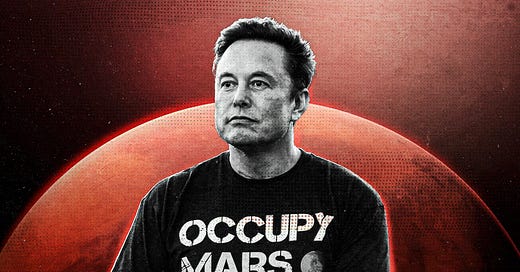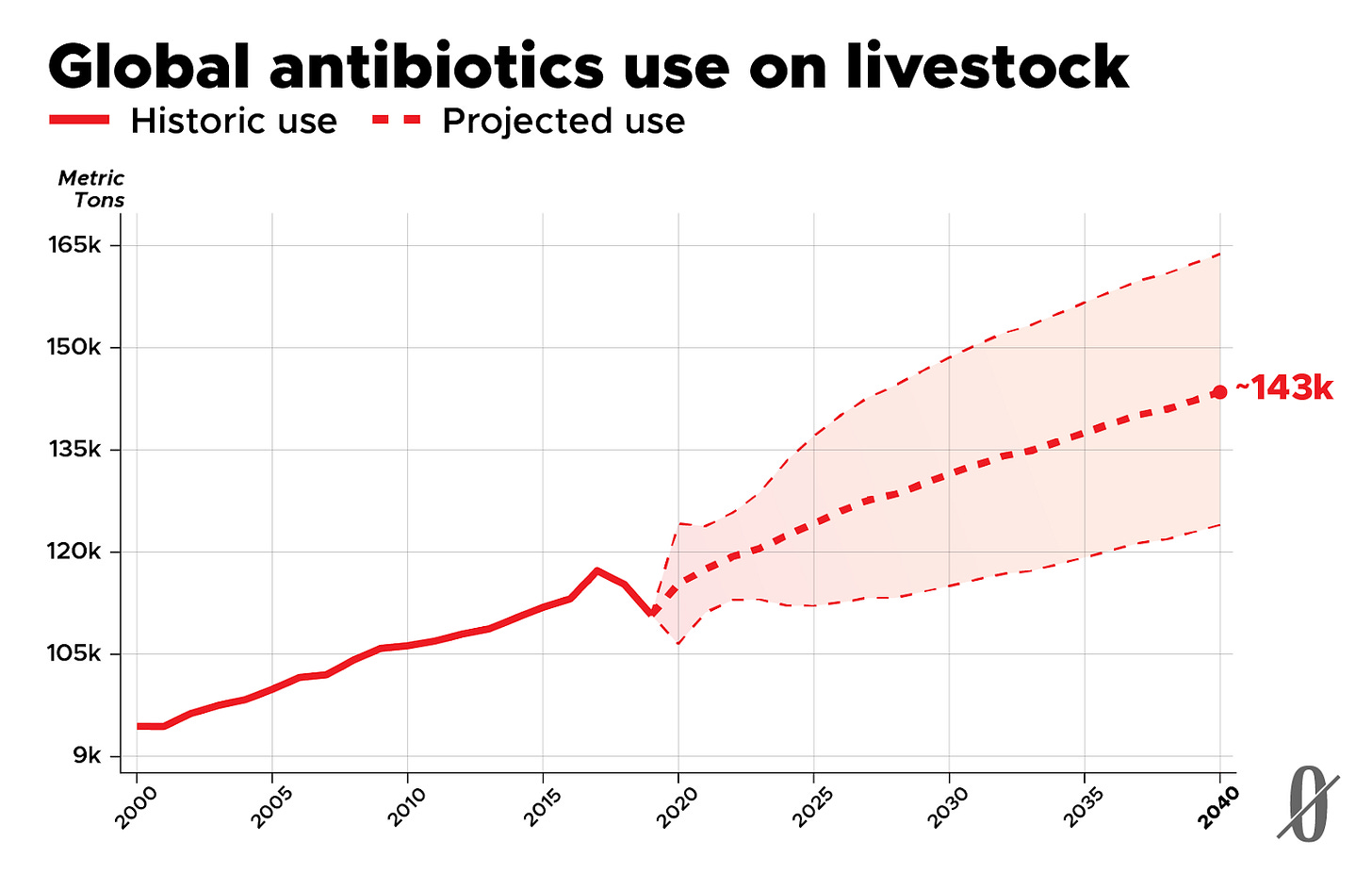Elon Musk’s NASA Takeover
Plus: Brain implant advances, international law regressions, Trump-Mao comparisons, a “massive show of force,” and more!
—In a move that CNN called a “massive show of force” aimed at Iran and Yemen’s Houthis, the US military moved six B-2 bombers to an island base in the Indian Ocean. B-2s can carry the largest bombs in the US arsenal, including “bunker busters” that could destroy underground Houthi hideouts or underground Iranian nuclear facilities.
—After Trump’s jarring announcement of broad and steep tariffs, a looming question was whether they would stay in place or prove fluid, selectively eased for countries that lower tariffs on US products (and perhaps rolled back a bit under pressure from US consumers or from the stock market). To the extent that the tariffs are perceived as fluid, Trump’s stated goal of incentivizing foreign companies to build factories in the US will be harder to reach. But if the tariffs stay as they are, the near-term inflationary effects could hurt Republicans in the midterm elections. (See yesterday’s NonZero newsletter for a very NonZeroesque way to buffer US workers against foreign competition without resorting to tariffs.)
—Major banks are preparing for a “severe future of global warming” in which temperatures blow past the limit, set by the 2015 Paris Climate Accords, of 2 degrees Celsius above pre-industrial levels, Politico’s E&E News reports. Morgan Stanley, citing “recent setbacks to global decarbonization efforts,” has told clients that it now expects warming to exceed 3 degrees Celsius—an increase that would intensify anticipated droughts and harvest failures and could raise sea levels by several feet.
—The world’s farmers are on pace to use 11 percent more antibiotics on livestock in 2035 than in 2025, according to projections published in Nature. The study’s authors warn that this trend could exacerbate the problem of antibiotic-resistant pathogens, and they recommend internationally coordinated changes in farming practices.
—Finland, as part of its preparation for possible war with Russia, will withdraw from a treaty that bans the use of anti-personnel landmines, said Finnish Prime Minister Petteri Orpo. Finland is the fifth European country to say it will pull out of the widely adopted Ottawa Treaty, following Poland, Estonia, Latvia and Lithuania.
—A team of Chinese researchers aims to put chips in the brains of 13 patients this year in a preliminary trial that “could see [the researchers] overtake Elon Musk's Neuralink in collecting patient data,” Reuters reports. Meanwhile, US-based scientists published details of a study in which an implanted chip turned brain signals into speech in near real-time—an improvement over prior technology, which generated bursts of audio only after patients finished a sentence.
—The Trump administration is weighing whether to allow a private company to start seabed mining in international waters—and is drawing blowback from friends and foes who say the move would violate international law, the New York Times reports. The vast majority of states agree that the International Seabed Authority is the only organization that can authorize such mining, but the White House has put forward a less constraining interpretation of international law. (See below for more on the challenges facing international law today.)
Wisconsin stood at the fulcrum of history this week, if you take Elon Musk’s word for it. During the runup to the state’s Supreme Court election, Musk argued that the outcome “might decide the future of America and Western Civilization,” not to mention “the entire destiny of humanity.” His logic was straightforward: Republican-backed candidate Brad Schimel had to win the race so that he could prevent Democratic-leaning judges from redrawing congressional districts in a way that would disadvantage the GOP. Save the Republicans, save the world.
As it happens, Schimel lost that race, and it wasn’t particularly close. While Musk had spent at least $25 million on the election, he claimed to be taking the results in stride. “I expected to lose, but there is value to losing a piece for a positional gain,” he posted, adding elsewhere that a successful ballot measure mandating voter IDs “was the most important thing.” This may be the false confidence of a man who has never been known to lose gracefully. Or it may be the all-too-real confidence of a man who views this as a minor setback in his plan to determine the future of mankind.
Indeed, even as Musk suffered a loss in Wisconsin, he made progress in his bigger quest: ensuring humanity’s survival by establishing a backup colony of a million people on Mars. Over the past two months, according to the Wall Street Journal, Musk has exerted a remarkable level of control over NASA, where he is working to “recast its programs, reallocate federal spending and install loyalists to aid his decadeslong goal of sending people to Mars.” The multi-billionaire hopes these efforts will bear fruit before Trump leaves office. In Musk’s view, it is “highly likely” that uncrewed SpaceX ships will be headed to Mars in 2026, followed by crewed missions in 2028.
The NASA takeover began late last year, when Musk persuaded Trump to nominate Jared Isaacman—a Musk ally and SpaceX astronaut—to lead the agency. While Isaacman awaits Senate confirmation, Musk has also dispatched a SpaceX executive to babysit the acting NASA administrator and ensure that the agency is shifting its focus toward Mars, according to the Journal.
Musk has primarily focused his attention on a program called Artemis, whose mission includes establishing “the first long-term presence on the Moon,” in part as a stepping stone to Mars, according to NASA’s website. Musk says the moon is a “distraction,” so he’s looking to kill many existing Artemis contracts—including multi-billion-dollar deals with Boeing, Jeff Bezos’ Blue Origin, and Musk’s own SpaceX—in order to replace them with Mars-focused investments. SpaceX employees are already telling people outside the company that “NASA’s resources will be reallocated toward Mars efforts,” the Journal wrote.
Meanwhile, SpaceX is developing a reusable vehicle that it hopes NASA will use to carry astronauts all the way to Mars. SpaceX says the rocket, dubbed Starship, will one day transport up to 100 people on “long-duration, interplanetary flights.” But for now, it’s having trouble getting off the ground. Starships exploded in both of their last two test flights, throwing fiery debris across the Caribbean.
SpaceX wants to iron out the kinks from these early tests by doing hundreds more flights in the coming years. This would require support not just from NASA but also from the Federal Aviation Administration, which has at times clashed with the company over launch regulations. Luckily for Musk, his authority is not limited to any one agency; he has the ear of President Trump, who has asked the billionaire to weigh in on potential changes to FAA policy, according to the Journal.
But the challenges facing Starship may be too big to fix with a few years of loose regulation. For one thing, SpaceX is only expected to test the vehicle four times in the first half of 2025, putting it on pace to conduct fewer tests by year’s end than the FAA has approved. Once the vehicle can reliably get into orbit, SpaceX will have to find a way to refuel up there by transferring “ultra-cold propellants from one ship to another—something never before attempted,” the Economist noted. Even if all the stars align, the peculiarities of interplanetary flight mean that Musk’s company will only have two windows during Trump’s presidency in which to attempt a trip to Mars, with one starting in late 2026 and another in late 2028.
Musk’s long-term goal faces a more fundamental problem. Whatever the world’s richest man may think, scientists have serious doubts about whether it would ever be possible to set up a sustainable colony on Mars, let alone a million-man settlement by 2050. The red planet is, in a word, brutal. It has a weak magnetosphere and little atmosphere, meaning that Martian colonists would be battered with possibly deadly levels of radiation and forced to remain inside pressurized domes or suits. The planet’s soil is believed to be toxic to humans, and once every five or so Earth years, that soil is whipped into a dust storm that covers the entire surface of the planet. Musk hopes to solve these problems by terraforming Mars through a series of nuclear explosions, but researchers say such an approach could touch off a nuclear winter. And even if we overcame all of those obstacles, the outpost would remain far too dependent on Earth to act as humanity’s “backup” in case of apocalypse at home, according to Robert Zubrin, an aerospace engineer and the president of the Mars Society. “The high-tech components of Mars’s most advanced systems will need to be imported from Earth for a very long time,” Zubrin wrote in UnHerd this week.
But none of that matters so long as Musk has the backing of the president and the power to realign NASA to serve his Mars mission. “There is no doubt that part of Mr Musk’s alliance with Mr Trump comes down to opportunism: the president’s authority hugely assists the goal of making travel to Mars first possible and then routine,” the Economist wrote recently. “In his megalomania, Mr Musk is using the American polity as a booster stage from which to launch the multiplanetary human destiny in which he believes himself to play a crucial role.” This may help explain why Musk has been able to dust himself off so quickly after a disappointing night in Wisconsin. Viewed from a Mars-bound Starship, political events here on Earth would seem very small indeed.








